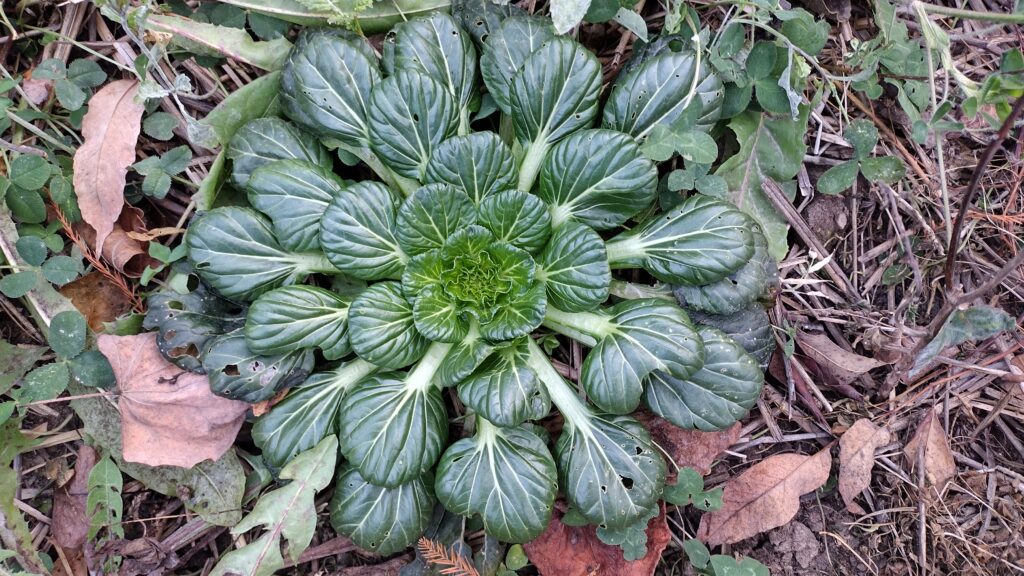Tatsoi – Rainbow
Tatsoi is an Asian variety Brassica, the same family that includes cabbages, that is grown for its green leaves. It is related to the often more familiar Bok Choi. The leaves form a beautiful rosette, and can be eaten by harvesting only the outer leaves or the entire head. And unlike Bok Choi, which has a tendency to bolt when weather quickly changes from cool temperature to summertime, Tatsoi remains tasty with a more creamy flavor, and beautifully shaped. It’s also tolerant of cold temperatures, and can be harvested from beneath snow.
Height: 8″-9″
Zones: —
Days to Harvest: 45 days
Container: yes
Deer Resistant: no
Plant Color: dark green
Bloom Color:
Life Cycle: annual
Spacing: 6″
Juglone Tolerant:
Sunlight: full to partial
Soil: medium
Water: medium
Design Styles: potager, and more formal plantings
Guild Use: no

History
Native to a region near the Yangtze River in Central China, Tatsoi has been cultivated since at least the 6th century. In Korea, Tatsoi is commonly used to make kimchi.
Uses
The ways you can use Tatsoi in your landscape or farm:
* as a cool season vegetable
* as a summer green to replace Bok Choi and Spinach
* for winter harvest
* for a decorative planting
Design
You can place Tatsoi as a decorative planting for landscape designs that include a more en masse planting. The rosette growth pattern of this plant, and it’s deep green and sometimes colorful stems, provide a clean geometric design. The leaves are shiny, and can provide a more youthful look to gardens that look tired by mid summer. Do note, however, that this plant may need a few plantings per year for a continued harvest into winter.

as other brassicas. This Tatsoi was grown without any protections.
Benefits
Tatsoi not only has benefits in the garden, but also is very nutritious and adaptable to many types of dishes. It can be used to make pesto, be added to cold and hot salads, tossed into stir fry’s, and added as an ingredient or as a garnish for soup.
Amount per 1 cup (100g)
Calories –
Total Fat 0.3 g
Saturated fat 0 g
Cholesterol 0 mg
Sodium 21 mg
Potassium 0 mg
Total Carbohydrate: 3.9 g
Dietary fiber 2.8 g
Sugar 0 g
Protein 2.2 g
___________________________________
Vitamin A 198%
Vitamin B1 (Thiamine) 5%
Vitamin B2 (Riboflavin) 5%
Vitamin B3 (Niacin) 3%
Vitamin B6 (Pyridoxine) 8%
Vitamin B9 (Folate) 40%
Vitamin B12 (Cobalamin) 0%
Vitamin C 217%
Vitamin D 8%
% Daily Value
0%
0%
0%
1%
0%
1%
11%
4%
___________________________________
Calcium 2%
Iron 8%
Magnesium 3%
Phosphorus 3%
Potassium 13%
Zinc 1%
Parting Thoughts
Tatsoi contains twice as much vitamin C than oranges, and twice as much calcium as milk. And this little power-houise vegetable provides carotenoids, important for the antioxidant benefit to your body.
To ensure that you are getting the most benefit from your Tatsoi, care for the soil so that it has the building blocks to make the most nutritious leaves for you to eat. And remember that carotenoids are fat-soluble, which means you’ll get the most nutrition when eating Tatsoi with some fats in the meal. And. lastly, the benefits of carotenoids increase when the vegetable is chopped and cooked.
Rezenience Gardens and Design is mission-driven and specializes caring for people and planet.
We do this by providing the most healthful varieties of plants, fruits, and seeds, through
environmentally sound design services, and by means of education.
#PeopleAndPlanet
@Rezenience
